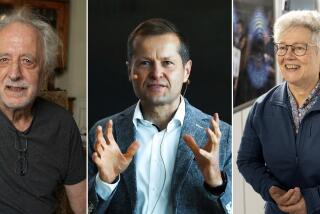The human eye can detect a single photon, study finds
- Share via
Your eyes may be more sensitive than you ever thought possible.
In a study published Tuesday in Nature Communications, researchers report that our warm, wet, multicellular eyes have evolved such a high level of sensitivity that they can, on occasion, detect a single photon aimed at the retina.
Even the most sophisticated man-made devices require a cool, temperature-controlled environment to achieve the same feat.
A single photon is the the smallest particle that light is made of, and it is extremely hard to see.
“It’s not like a dim flash of light or anything like that,” said Alipasha Vaziri, a quantum physicist at Rockefeller University in New York City and the senior author on the paper. “It’s more a feeling of seeing something rather than really seeing it.”
He described it, poetically, as being “at the threshold of imagination.”
“If you’ve ever looked at a faint star in the night sky and one second you see it but the next second you don’t — it’s kind of like that,” he said.
See the most-read stories in Science this hour »
Previous studies dating back to the 1940s have shown that the human eye can detect as few as five to seven photons. But whether a single photon would be detectable proved elusive.
Although scientists were able to create light sources that produced an average of one photon at a time, they couldn’t know for sure whether one, two, three or zero photons were released each time the light source was fired.
To solve this problem, Vaziri’s team used a process known a spontaneous parametric down-conversion (SPDC) in which a high-energy photon decays spontaneously in a crystal into two lower energetic photons. One of these photons is directed to a subject’s eye while the other is sent to a detector. If the detector notes a photon, then the researchers know the other half of the pair had to be sent to the observer.
The study group was extremely small. There were only three participants -- all male and all in their 20s. They all had excellent eyesight, although one subject had his contact lenses to thank for that.
Before the experiment began, each participant sat in a completely dark room for about 40 minutes to make sure his eyes were fully adapted to the dark. His head was held in place with a headrest and a bite bar to ensure that when the photon was released it would be directed at the most sensitive part of his retina.
When the subject felt ready he triggered the start of the experiment by pressing a button. Soon he would hear two acoustical signals separated by one second. Afterwards, he was asked to indicate which signal he thought was accompanied by a photon and which one was a blank. Finally, he had to rate how confident he was in his choice on a three point scale.
Vaziri said the strategy of forcing the participants to make a choice — even when they weren’t sure it was right — helped push the subjects to maximum sensitivity.
“It was key for the results of the study,” he said.
Producing a single photon or any number of defined states of light is not easy. Only recently researchers, mainly working in the field of quantum optics and quantum information, have been able to generate such light states more routinely, Vaziri said. The setup requires special crystals and high-efficiency detectors, but even then the production rate of single photons is quite low.
In this case of 30,767 trials, only 2,420 were single-photon events, the authors wrote. However, those blank trials served as a control, allowing the authors to determine if the subjects were biased; for example, if they were more likely to think the second signal was accompanied by a photon. It also provided valuable information on participants’ default confidence levels, Vaziri said.
The researchers report that the subjects were able to correctly determine when a photon had been fired 51.6% of the time, which may not sound that impressive, but is statistically significant.
“If it was really random guessing, there would be no way to explain this result,” Vaziri said.
In addition, when the subjects expressed high confidence that they had seen a photon, they were right 60% of the time.
The authors also found that the observers were more likely to correctly detect a single photon when they had been exposed to another photon within the past 10 seconds.
Although they do not know what mechanism would cause this fleeting increase of sensitivity, Vaziri speculated that it could have an evolutionary advantage.
“If you are dealing with really dim conditions and you see one photon, seeing another shortly afterwards would help your visual system recognize that it really is a light source,” he said.
He added that while his group did not know just how sensitive the human eye could be before they started this research, it makes sense that our eyes have evolved to spot even the tiniest bit of light.
“People don’t realize it, but if you are in nature, far from any city, on a moonless night and under a starry sky, the ambient light can get to the level of a single photon,” he said. “In those conditions, the difference between being able to see a little better to escape predators could have an evolutionary effect.”
Do you love science? I do! Follow me @DeborahNetburn and “like” Los Angeles Times Science & Health on Facebook.
MORE IN SCIENCE
Zika epidemic in Latin America may have peaked, and scientists predict it will be over in 3 years
DNA from ancient skeletons suggests farming was invented multiple times in the Fertile Crescent
Brain changes wrought by gene linked to Alzheimer’s may begin in childhood, scientists say





